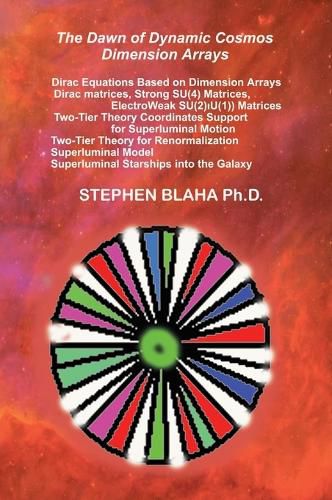Readings Newsletter
Become a Readings Member to make your shopping experience even easier.
Sign in or sign up for free!
You’re not far away from qualifying for FREE standard shipping within Australia
You’ve qualified for FREE standard shipping within Australia
The cart is loading…






This book shows all the matrices that are present in the Dirac equations for derivative terms, SU(4) and SU(3)?U(1) Strong Interactions, and the SU(2)?U(1) Electroweak Interactions have a common origin in Cosmos Theory dimension arrays. These interactions are present throughout our universe's Unified SuperStandard Theory and also in universes of higher space-time dimension. (Cosmos universes have dimensions ranging from zero through 18.)
The natural form of the Dirac equations lend themselves to being defined with the author's Quadplex fermion wave functions presented in earlier books. Combined with earlier books on Cosmos Theory we have complete elementary particle formalism.
We have suggested in the past that Cosmos Theory should be based on the author's Two-Tier Theory of 2002.
A major reason for using Two-Tier Theory is its ability to eliminate similar infinities that would appear in higher dimension universes, which are likely to be present in the Cosmos. (Other approaches to renormalization do not apply in higher dimension space-times.) This book provides a thorough presentation of Two-Tier Theory.
A possible benefit of Two-Tier Theory is its use of Two-Tier coordinates which are complex-valued (although approximated with real-valued coordinates at low energies). These coordinates have an inherent oscillatory nature. They can be used in a model, presented in this book, that supports transitions between subluminal and superluminal (faster than light) motion.
A potential application of models of this type would be the development of starships for speedy transport to the stars at velocities well in excess of light speed. To this end the book considers: superluminal motion, potential problems related to superluminal starships, and instantaneous interstellar communication via quantum entanglement. The Superluminal motion in this model is directly based on Two-Tier Theory.
This book, and the author's previous books, shows the Cosmos is a compact, highly structured set of spaces, universes, and particle dynamics.
$9.00 standard shipping within Australia
FREE standard shipping within Australia for orders over $100.00
Express & International shipping calculated at checkout
This book shows all the matrices that are present in the Dirac equations for derivative terms, SU(4) and SU(3)?U(1) Strong Interactions, and the SU(2)?U(1) Electroweak Interactions have a common origin in Cosmos Theory dimension arrays. These interactions are present throughout our universe's Unified SuperStandard Theory and also in universes of higher space-time dimension. (Cosmos universes have dimensions ranging from zero through 18.)
The natural form of the Dirac equations lend themselves to being defined with the author's Quadplex fermion wave functions presented in earlier books. Combined with earlier books on Cosmos Theory we have complete elementary particle formalism.
We have suggested in the past that Cosmos Theory should be based on the author's Two-Tier Theory of 2002.
A major reason for using Two-Tier Theory is its ability to eliminate similar infinities that would appear in higher dimension universes, which are likely to be present in the Cosmos. (Other approaches to renormalization do not apply in higher dimension space-times.) This book provides a thorough presentation of Two-Tier Theory.
A possible benefit of Two-Tier Theory is its use of Two-Tier coordinates which are complex-valued (although approximated with real-valued coordinates at low energies). These coordinates have an inherent oscillatory nature. They can be used in a model, presented in this book, that supports transitions between subluminal and superluminal (faster than light) motion.
A potential application of models of this type would be the development of starships for speedy transport to the stars at velocities well in excess of light speed. To this end the book considers: superluminal motion, potential problems related to superluminal starships, and instantaneous interstellar communication via quantum entanglement. The Superluminal motion in this model is directly based on Two-Tier Theory.
This book, and the author's previous books, shows the Cosmos is a compact, highly structured set of spaces, universes, and particle dynamics.